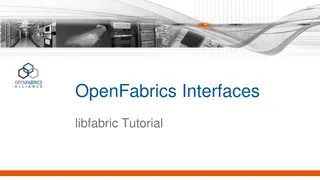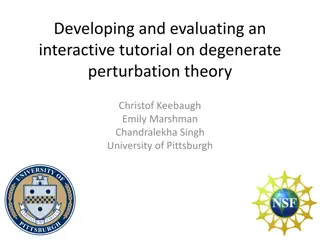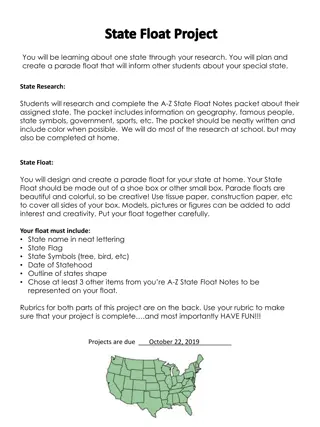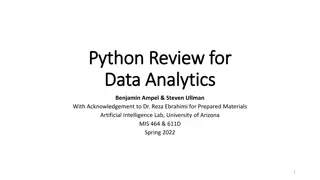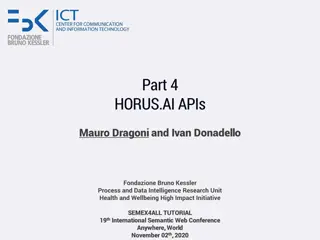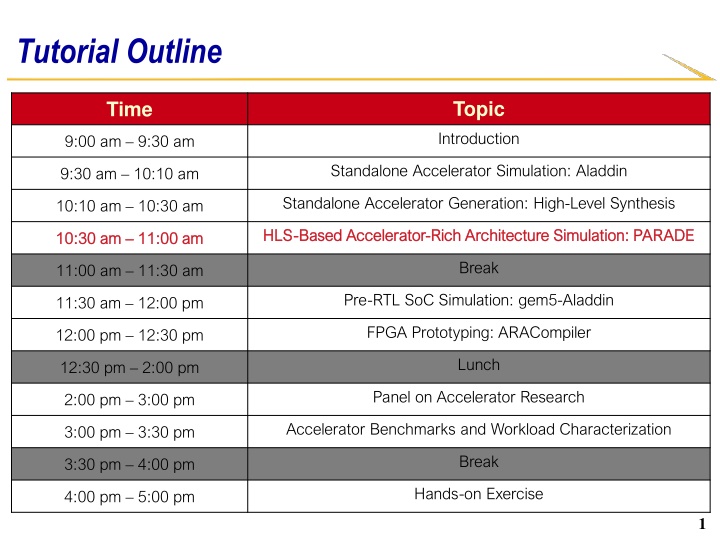
Accelerator-Rich Architecture: Research Tools and Simulation Techniques
Explore a comprehensive agenda covering various aspects of accelerator-rich architecture, from standalone simulation to FPGA prototyping. Key topics include Aladdin simulation, High-Level Synthesis (HLS) generation, PARADE architecture simulation, gem5-Aladdin SoC simulation, and more. Join the discussion on accelerator research, benchmarks, and workload characterization, aimed at advancing the adoption of accelerator-rich architecture.
Download Presentation

Please find below an Image/Link to download the presentation.
The content on the website is provided AS IS for your information and personal use only. It may not be sold, licensed, or shared on other websites without obtaining consent from the author. If you encounter any issues during the download, it is possible that the publisher has removed the file from their server.
You are allowed to download the files provided on this website for personal or commercial use, subject to the condition that they are used lawfully. All files are the property of their respective owners.
The content on the website is provided AS IS for your information and personal use only. It may not be sold, licensed, or shared on other websites without obtaining consent from the author.
E N D
Presentation Transcript
Tutorial Outline Topic Introduction Time 9:00 am 9:30 am Standalone Accelerator Simulation: Aladdin 9:30 am 10:10 am Standalone Accelerator Generation: High-Level Synthesis 10:10 am 10:30 am HLS HLS- -Based Accelerator Based Accelerator- -Rich Architecture Simulation: PARADE Rich Architecture Simulation: PARADE 10:30 10:30 am am 11:00 am 11:00 am Break 11:00 am 11:30 am Pre-RTL SoC Simulation: gem5-Aladdin 11:30 am 12:00 pm FPGA Prototyping: ARACompiler 12:00 pm 12:30 pm Lunch 12:30 pm 2:00 pm Panel on Accelerator Research 2:00 pm 3:00 pm Accelerator Benchmarks and Workload Characterization 3:00 pm 3:30 pm Break 3:30 pm 4:00 pm Hands-on Exercise 4:00 pm 5:00 pm 1
PARADE: A Cycle-Accurate Full-System Simulation Platform for Accelerator-Rich Architectural Design and Exploration [ICCAD 15] Zhenman Fang, Michael Gill Jason Cong, Glenn Reinman Center for Domain-Specific Computing Center for Future Architectures Research Computer Science Department, UCLA
The Power Wall and Customized Computing Parallelization Customization Adapt the architecture to application domain Source: Shekhar Borkar, Intel 3
The Trend of Accelerator-Rich Architecture (ARA) From ARC [DAC 12] & CHARM [DAC 14] Global Accelerator Manager (GAM) with shared TLB 4
Our Motivation and Goal A stack of research tools for accelerator-rich architecture Standalone accelerator simulation: Aladdin Standalone accelerator generation: HLS System-level HLS-based ARA simulation: PARADE System-level pre-RTL SoC simulation: gem5 + Aladdin ARA FPGA prototyping: ARACompiler early-stage late-stage Spare the community the difficulties we have encountered Accelerate the adoption of accelerator-rich architecture (ARA) 5
PARADE: Platform for Accelerator-Rich Architectural Design & Exploration [ICCAD 15] auto-generated accelerators based on HLS (AutoPilot) extended m5 (McPAT) for X86 CPU, with OS added SPM, DMA, GAM & TLB model extended Garnet (DSENT) for NoC gem5 memory model [ISPASS 14] extended Ruby (CACTI) for coherent cache hierarchy 6
HLS-based Automatic Accelerator Generation Accelerator Source Code C function to accelerate High-Level Synthesis Application Dataflow Simulation Module Generator RTL model Accelerators chaining info RTL Simulation module info Synthesis Timing info e.g., II, clk Program Generator Simulation Module Generated Program Handles accelerator communication, task buffer, interrupts, Input Tool Output 7
Visualization Support L1D_0 core_0 acc_0 L1D_1 router_0 router_1 L2_0 L2_1 L1D_2 GAM acc_1 L1D_3 router_2 router_3 L2_2 mc_0 L2_3 According to the component s utilization, assign a different color. The dark red indicates a potential bottleneck! 8
Tutorial Agenda Building the PARADE simulator Creating a benchmark Running a benchmark on PARADE Performance and energy analysis using PARADE Performance breakdown Energy breakdown Simulation speed of PARADE Summary of PARADE features 9
Building PARADE Use an existing accelerator module: VectorAddSample #include "VectorAddSample.hh in LCAccOperatingModeInclude.hh VectorAddSample.hh contains accelerator modeling details REGISTER_OPMODE(OperatingMode_VectorAddSample) in LCAccOperatingModeListing.hh g_LCAccInterface->AddOperatingMode(g_LCAccDeviceHandle[0], "VectorAddSample"); in startup() mem/ruby/system/System.cc The same compiling command as gem5 (32nm @2GHz) scons PROTOCOL=MESI_Two_Level_Trace build/X86/gem5.opt 10
Adding an Accelerator Simulation Module User high-level description: VectorAddSample.type Specify an unique accelerator module name and opcode 1390 uw 52806 um2 10 2 (1GHz) 1 Replace timing by our HLS/RTL tool ./run.autopilot.sh VectorAddSample.type Specify accelerator inputs and outputs Specify accelerator computation body: one iteration in the loop 11
Auto-Generated Accelerator Simulation Module Auto-generated accelerator module: VectorAddSample.hh each accelerator inherits the LCAccOperationMode class accelerator module name and opcode accelerator timing info from HLS/RTL auto-generated SPM address mapping model SPM/DMA timing, and computation latency mono AccGen.exe - path:src/modules/LCAcc VectorAddSample.type 12
Creating a Benchmark To use existing accelerators, just call accelerator API base BenchmarkNode class include acceleratorAPI inherit BenchmarkNode call the CreateBufferAPI to init the accelerator, write the program description to memory buffer call the run_bufAPI to read the accelerator, run it, handle the communication with CPU and GAM Create a BenchmarkNode, call Initialize() and Run() 13
Within the Accelerator Library (for Benchmarks) 3 New ISA lcacc-req type lcacc-rsrv id, time lcacc-cmd id, cmd, addr lcacc-free id 1 GAM CPU 2 4 4 5 7 5 Task description 6 Mem Acc 4 1. Request available accelerators (lcacc-req) 2. Response available ones & waiting time 3. Request reservation (lcacc-rsv) and wait 4. Reserve accelerator, send it the core ID 5. The core shares a task description and start the accelerator (lcacc-cmd) 6. Read task & start work 7. Work done, notify the core 8. Free accelerators (lcacc-free) Users don t have to worry about these, we provide a dataflow language and tool to automatically generate the library 14
Creating an Accelerator Library (for Benchmarks) To create an accelerator library, specify accelerator dataflow (mono ApGen.exe VectorAddSample.txt VectorAddSampleLCacc.h) input and output whole data size and tile size task based on tile size (chunk) use double SPM buffer declare the accelerator create SPM for input/output data transfer based on tile: input LLC/DRAM -> SPM & output SPM -> LLC/DRAM trigger accelerator within tile: input SPM -> Register & output Register -> SPM 15
Running a Benchmark on PARADE Similar gem5 command to run benchmarks ./gem5.opt --outdir=./TDLCA_BlackScholes/ configs/example/fs.py --checkpoint-dir=./ckpt-1core/ --restore-with-cpu=timing -r 1 -n 1 -s 16565183 -W 16565183 --ruby --l2_size=64kB --num-l2caches=32 --mem-size=2GB --num-dirs=4 --garnet=fixed --topology=Mesh --mesh-rows=4 --lcacc --accelerators=1 --script=./configs/boot/BlackScholes.td.rcS >& TDLCA_BlackScholes/result.txt full-system config restore checkpoint timing warmup initialization, then switch to OoO 32-banked 2MB LLC with Ruby 2GB memory with 4 DDR3 controllers 4*8 mesh with Garnet 1 copy of accelerator BlackScholes boot script redirect output to result.txt Output statistics of PARADE Stats.txt, result.txt, and visual.txt (visualization trace) 16
Execution Cycles for BlackScholes BlackScholes-SW BlackScholes-dedicated-ARA 1,000,000,000 100,000,000 Execution cycles 10,000,000 94X 64X 155X 1,000,000 100,000 10,000 Total Computation Non-overlapped Communication 17
Execution Cycles for BlackScholes (cont.) Total cycles: check stats.txt system.switch_cpus_1.numCycles 3158763 CPU/SW computation time (assume perfect cache) Change configuration to use 20MB L2 cache with 1 cycle latency ARA computation/communication time Result.txt contains start, and end time for each task computation and data transfer Postprocessing ResultParser result.txt , it will generate 18
Issuing IPC Breakdown for BlackScholes # of issued instructions per cycle on CPU (BlackScholes) 1% 1% 1% 3% 5% issue_0 issue_1 issue_2 issue_3 issue_4 issue_5 issue_6 issue_7 issue_8 5% 7% No issuing instruction 15% 62% For the accelerator version, it s customized to a fully-utilized 234-stage deep pipeline 19
Issuing IPC Breakdown for BlackScholes (cont.) Check stats.txt ARA version based on HLS ./run.autopilot.sh BlackScholes.type 20
# of Cache/Memory Access for BlackScholes BlackScholes-SW BlackScholes-dedicated-ARA 42X L1D reduction by removing register spilling 100,000,000 removed instructions 10,000,000 no notable reduction # of accesses 1,000,000 100,000 10,000 L1D/SPM L1I LLC Memory 21
# of Cache/Memory Access for BlackScholes (cont.) Check stats.txt 22
Cache/Memory Bandwidth for BlackScholes Bandwidth = Access * 64B * 10-6/ (Cycles/2GHz) (MB/s) BlackScholes-SW BlackScholes-dedicated-ARA improved LLC/DRAM effective bandwidth 100,000 10,000 Bandwidth (MB/s) 1,000 100 10 1 L1D/SPM LLC Memory 23
Energy Breakdown for Deblur Energy breakdown for dedicated ARA (Deblur) 14% Core_Acc LLC NoC DRAM 12% 7% 67% 24
Energy Breakdown for Deblur (cont.) Energy = power * time, we measure power directly Accelerator power: given by run.autopilot.sh DRAM power (gem5 integrated Micron model, ISPASS 14) system.mem_ctrls0.averagePower::0 753.996167 Core power (McPAT) generate.mcpat.xml.sh convert gem5 statistics to mcpat xml generate.mcpat.energy.sh generate power numbers in stats.txt 25
Energy Breakdown for Deblur (cont.) LLC power (CACTI, integrated with McPAT) NoC power (DSENT) run generate.dsent.sh 26
Simulation Speed of PARADE KIPS: Kilo Instructions simulated Per Second gem5-SW_KIPS PARADE-dedicated-ARA-speedup 70 7 15X PARADE speedup 60 6 gem5 KIPS 50 5 40 4 30 3 20 2 10 1 0 0 Robot_Localization Denoise Segmentation StreamCluster Texture_Synthesis Registration BlackScholes Swaptions Deblur EKF_SLAM LPCIP_Desc Disparity_Map Medical Imaging Commercial Vision Navigation 27
PARADE: Platform for ARA Design & Exploration Based on widely-used gem5 and support full-system X86 Global Accelerator Management (GAM) Coherent cache/SPM with shared memory (Ruby) Customizable Network-on-Chip simulation (Garnet) Power/area simulation McPAT for CPUs; high-level synthesis (AutoPilot) for accelerators CACTI for caches; DSENT for NoC, Micron model for DRAM Visualization to assist design space exploration 28
Thank You! For more information, please contact Zhenman Fang, zhenman@cs.ucla.edu Tutorial website: http://accelerator.eecs.harvard.edu/isca15tutorial/ 29










